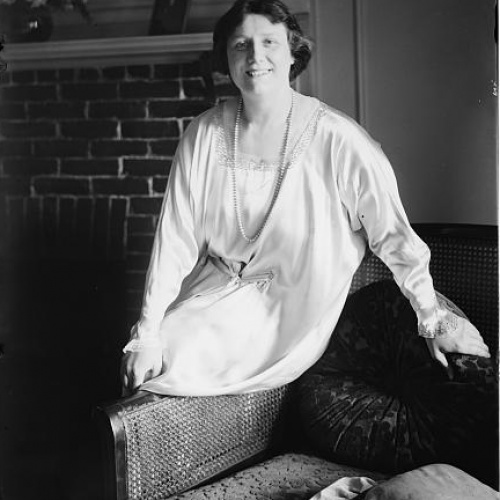Leila Megane: the opera star from Llŷn and Eifionydd
5 April 2023
One of Wales' most popular singers of the last century will be celebrated during this year's Llŷn and Eifionydd National Eisteddfod
Mezzo-soprano, Leila Megàne, spent her career travelling throughout Europe and the United States performing and captivating audiences.
Margaret Jones was born in Bethesda on 5 April 1891, one of ten children of a police officer and his wife. The family moved to Morfa Nefyn before later moving to Pwllheli where she received her early education. And after a successful career she returned to Wales and lived in Pen Llŷn for years where she was active and influential in the cultural life of the area until her death in 1960.
This year’s Cymanfa Ganu Choir will sing new arrangements of her songs, and the choir of over a hundred mixed voices, conducted by Pat Jones and accompanied by Ilid Anne Jones, has been practicing hard since the beginning of the year.
During a break in practice at Ysgol yr Hendre, Caernarfon Ilid Anne Jones said: "Leila Megàne was one of the most popular, most famous singers in Wales in her day.
"Her birth name was Margaret Jones and she became Megan Jones when she had vocal lessons in London and then, Leila Megàne was her stage name. She was given this name by Jean de Reszke, her vocal coach, in Paris in 1912.
"Her contribution to Welsh musical culture is enormous. She sang Welsh songs on the world’s biggest stages, and would never leave a concert stage without singing a Welsh solo.
"She married composer, Thomas Osborne Roberts, and motivated him to compose and arrange Welsh solos for her. She also established a scholarship, the Blue Ribband for young people under 25, the Osborne Roberts Memorial Award, to encourage young singers to continue their careers."
Ilid added that the choir will sing a selection of arrangements of popular songs that Leila Megane sang - Gwlad y Delyn, Bwthyn Bach To Gwellt, Pistyll y Llan, Dafydd y Garreg Wen and Y Nefoedd. The arrangements were prepared by Ilid and edited by Huw Gwynne, Cricieth.
Ilid is an expert on the life and work of Leila Megàne, having researched her life and times for her MPhil. An adaptation of her research will be published in a special volume - Leila Megàne - Ei Dawn a'i Stori – in time for this year’s National Eisteddfod.
"For me, I've done research on her and I've lived Leila Megàne for years, not just by doing the research but afterwards as well," said Ilid.
Leila Megàne's early life was not easy. Her mother died when she was only seven years old and her father sacrificed a great deal to nurture her musical talent. She made her first solo appearance at an Eisteddfod in Biwmares in 1910.
She won her first professional contract at the Opéra Comique in Paris. During the First World War she entertained wounded soldiers in France, drawing the attention of prominent politicians including Winston Churchill and the Prime Minister, David Lloyd George.
In 1919 she signed a contract at the Covent Garden Opera House and made her debut in Thérèse Massenet. In 1922 she was part of the first complete recording of Sea Pictures by Edward Elgar, with the composer himself conducting.
When she sang at the Metropolitan Opera in New York in 1923, Thomas Osborne Roberts was her accompanist. They married in New York in 1924 and settled in Caernarfon where their daughter, Isaura, was born.
Leila Megàne took part in the Great Concert of the National Eisteddfod in Pwllheli in 1925. The concert was broadcast as one of the BBC's first broadcasts in Wales. But only listeners in the Cardiff area heard the broadcast - and there was no trace of Leila Megàne on the recording - as there was a clause in her contract prohibiting the broadcasting of her voice.
Osborne Roberts was the organist at the English Chapel on Y Maes, Caernarfon, choirmaster at Capel Moreia and a music teacher. He wrote some of his most famous compositions in Caernarfon - Y Nefoedd, Pistyll y Llan and Cymru Lân. The family went to London in the 1930s and to Denbighshire at the start of the Second World War. By then Leila Megàne had retired as a singer.
After she retired from the stage, and especially after the death of Osborne Roberts in 1948, she became prominent in the social life of Pen Llŷn. She remarried in 1951 to her friend and accompanist, William John Hughes. Her social activities mostly revolved around the Capel Berea, Efailnewydd.
At the 1951 National Eisteddfod, held in Llanrwst, the T Osborne Roberts scholarship (The Blue Ribband) was established.
Leila Megàne died on 2 January 1960 aged 68. According to her wish there were no flowers or mourning at her funeral. She was buried in Penrhos Cemetery on the outskirts of Pwllheli. But her music and legacy live on to this day.

